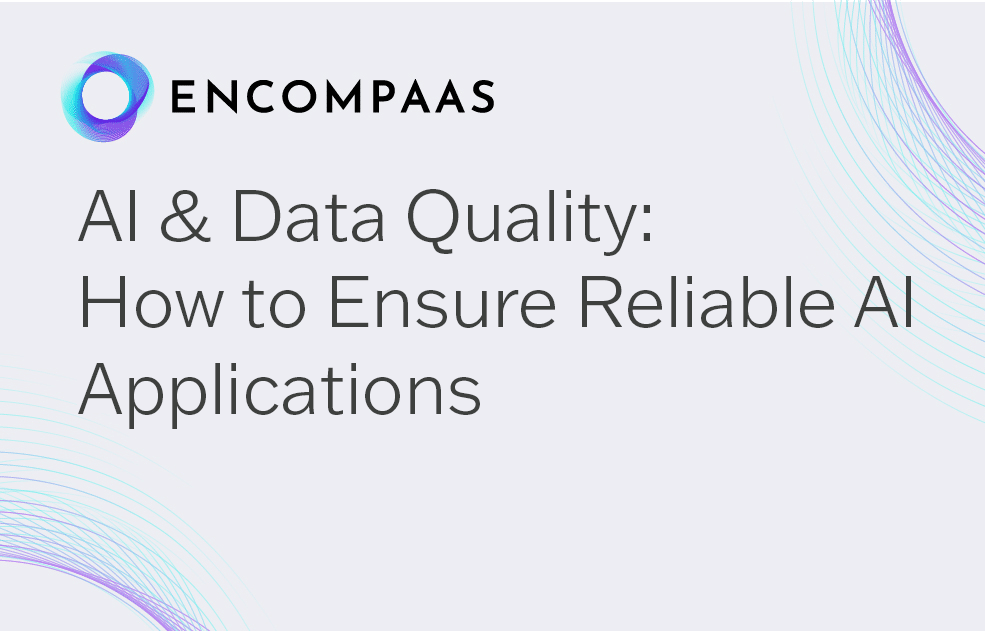AI and Data Quality: How to Ensure Reliable AI Applications
Authored by EncompaaS - Mar 12, 2023
Share

In today’s data-driven world, Artificial Intelligence (AI) has become a transformative force across industries. From automating tasks to generating personalized recommendations, AI applications are revolutionizing how we work and live. However, the success of these applications depends on one critical element: data quality.
AI applications rely on high-quality data to deliver accurate and reliable results.
This blog post explores the critical link between data quality and AI performance and unveils best practices to ensure clean, reliable data power your AI applications.
Main takeaways from this article:
- The effectiveness of AI applications relies heavily on the quality of the data they use. Accurate, complete, consistent, and timely data help unlock reliable AI performance and optimal outcomes from AI investments. On the other hand, poor data quality can lead to flawed decisions, biases in AI models, and ineffective AI applications.
- To ensure the reliability of AI systems, specific data quality metrics must be maintained. These include accuracy (data must reflect true values), completeness (no crucial information should be missing), consistency (data should adhere to a standardized format), and timeliness (information must be up-to-date).
- AI projects often face data quality issues such as missing values, duplicate records, inconsistent formats, and biased datasets. These can lead to inaccurate AI predictions and biased models, thereby impacting the overall effectiveness of AI applications.
- Best practices for ensuring data quality include establishing robust data governance frameworks, implementing rigorous data collection protocols, continuous data cleansing processes, and using advanced data validation techniques, which are critical for maintaining data integrity.
- Leveraging sophisticated data quality tools like EncompaaS can further enhance the efficiency and reliability of data used in AI systems.
Understanding data quality metrics
Imagine feeding an AI model for image recognition with blurry, mislabeled photos. The results would likely be inaccurate and unreliable. This is why measurable data quality is so important.
Here are the key metrics to consider:
- Accuracy: This metric refers to the fidelity of your data and how closely it reflects reality. Inaccurate data, such as incorrect customer addresses or faulty sensor readings, can lead to misleading results in AI models.
- Completeness: A complete dataset ensures no crucial information is missing. Missing values can skew the interpretation of data and hinder the performance of AI algorithms.
- Consistency: Consistency implies that data adheres to a defined format and follows established rules. Inconsistent data, like varying date formats or conflicting product descriptions, creates confusion and reduces the reliability of AI outputs.
- Timeliness: Data needs to be current and relevant for AI applications. Outdated information can lead to inaccurate predictions and hinder the effectiveness of AI systems.
These metrics act like a measuring stick, evaluating the health and performance of your data. By regularly evaluating your data against these metrics, you can identify areas for improvement and ensure your data is in top shape to fuel your AI initiatives.
By tweaking and optimizing your data, you can enhance its quality and thereby improve AI system precision and efficacy.
The importance of high-quality data in AI
The quality of your data directly impacts the reliability and performance of your AI models. Imagine feeding an AI application designed for fraud detection with a dataset full of inconsistencies and errors. The model might flag legitimate transactions as fraudulent, leading to financial losses and customers’ frustration over the smallest transaction.
Several examples can be cited to demonstrate the consequences of poor data quality in AI. For instance, a facial recognition system trained on biased data sets might exhibit racial disparities in its accuracy.
An AI-driven healthcare application may misdiagnose patients due to the use of an incomplete and unclean health dataset. These scenarios emphasize the need for meticulous data management practices to ensure that AI applications are effective, fair, and unbiased.
AI data quality management challenges and risks
Maintaining high-quality data for AI applications comes with its own set of challenges.
Here are some common data quality issues that can plague AI projects:
- Missing values: Incomplete data sets with missing entries can lead to biased models and inaccurate predictions.
- Duplicate records: Duplicate entries in records add to data volume and can skew training data, impacting model performance.
- Inconsistent formats: Inconsistent data formats (e.g., dates, units) create confusion and make it difficult for AI algorithms to interpret the data accurately.
- Data bias: Biased data sets can lead to discriminatory AI models perpetuating societal inequalities.
These issues, if left unchecked, can significantly impact the effectiveness of your AI models. Poor data quality can lead to:
- Biased models: Biased data leads to biased models that produce discriminatory or unfair outputs.
- Inaccurate predictions: Unreliable data results in inaccurate predictions, hindering the ability of AI models to make informed decisions.
- Wasted resources: Time and money spent training models on flawed data are wasted resources.
Best practices for ensuring data quality in AI systems
Building reliable AI applications starts with establishing a solid data foundation. Here are some best practices to consider:
1. Establish a robust data governance framework
A well-defined data governance framework sets the stage for data quality. This framework outlines the roles and responsibilities for data management within your organization.
Here’s what it entails:
- Data stewards: Appoint data stewards who are accountable for the accuracy and integrity of data within their specific domain (e.g., customer data, financial data). These stewards act as champions for data quality and ensure adherence to data governance policies.
- Data governance policies: Establish clear policies for data collection, storage, usage, and access. These policies ensure consistency in handling data across the organization, minimizing errors and promoting data security.
2. Implement rigorous data collection protocols
Meticulous data collection practices are crucial for ensuring data integrity from the outset.
This involves three key steps:
- Validate data sources: Before relying on any data source, assess its credibility. Are the sources reputable? How was the data collected? Understanding the source’s data collection practices helps identify potential biases or limitations.
- Establish clear data collection methods: Define a standardized approach for acquiring data. This could involve creating data collection forms, outlining specific data points required, and specifying acceptable formats (e.g., date format, units of measurement).
- Implement quality checks at the point of entry: Don’t wait until later to ensure data quality. Integrate quality checks during the data entry process itself by using predefined drop-down menus for specific choices, establishing range checks for numerical data, and employing real-time data formatting tools.
3. Establish continuous data cleansing processes
Data is a living entity. Even the most meticulously collected data can become outdated or contain errors over time. Regular data cleansing routines are essential to maintain high-quality data.
- Duplicate removal: Duplicate records skew analysis and inflate storage costs. Regular cleansing identifies and eliminates duplicate entries, ensuring data accuracy and efficient resource use.
- Error correction: Typos and inconsistencies can creep in over time. Cleansing routines involve identifying and correcting these errors, ensuring data reflects reality accurately.
- Outdated information update: Information changes – addresses move, product details evolve. Data cleansing helps identify and update outdated information, allowing your AI models to work with the most current data available.
4. Develop robust data validation and verification techniques
Data collection and cleansing are important first steps. Still, to truly ensure data quality, we need to build robust validation and verification techniques that act as a much-needed safety net and provide an extra layer of confidence in the accuracy and integrity of your data. Use techniques such as:
- Range checking: This technique ensures that data points fall within predefined acceptable ranges. For example, checking if an age value falls between 18 and 120 helps identify potential errors.
- Cross-reference checks: Cross-referencing data across different sources can reveal inconsistencies. For instance, comparing customer addresses between a CRM system and a loyalty program database.
- Anomaly detection: This method uses math-based rules to find data points that are very different from the usual. These odd points could be true exceptions, but they might also suggest mistakes or mismatches that need more study.
5. Use data quality tools
Several data quality tools automate aspects of data cleansing, validation, and monitoring. These tools can be invaluable in streamlining your data management processes by:
- Identifying and flagging potential inconsistencies.
- Automating repetitive data cleansing tasks.
- Providing data quality reports and dashboards for ongoing monitoring.
While traditional data quality tools offer significant benefits, EncompaaS takes data quality a step further.
EncompaaS offers a comprehensive data quality platform designed to transform raw data, regardless of its form (structured, unstructured, or semi-structured), into a high-quality data layer that supercharges the functionality of AI and machine learning models. Here’s what this platform empowers you to achieve:
- AI-powered transformation: EncompaaS leverages generative AI to automate data cleansing, enrichment, and transformation tasks. This not only improves efficiency but also ensures a level of accuracy that traditional tools may struggle to achieve.
- Risk mitigation: EncompaaS’ unique “re-risking” capabilities ensure your data meets the latest compliance regulations and security standards. This minimizes risks associated with data governance and privacy concerns.
Leverage EncompaaS for superior data quality
Today, AI has revolutionized how businesses operate. However, the success of AI heavily depends on the quality of the data it uses. Poor-quality data can lead to issues such as bias in AI models, incorrect predictions, wasted resources, and failed AI projects.
The good news is that achieving and maintaining data quality is well within your reach. You can build a solid foundation for your AI applications by implementing the best practices outlined above. This is where EncompaaS comes in to streamline the process with a unique combination of advantages like:
- Unmatched versatility: It handles all data types, seamlessly integrating structured data with unstructured text and images to allow you to leverage your data’s full potential for AI development.
- AI-powered transformation: EncompaaS leverages generative AI to automate data cleansing and enrichment tasks, ensuring a level of accuracy that surpasses traditional tools.
- Risk mitigation: EncompaaS’ capabilities ensure your data adheres to the latest compliance regulations and security standards, minimizing risks associated with data governance.
By integrating EncompaaS into your AI development process, you can unlock a multitude of benefits:
- More reliable AI applications built with high-quality data
- Optimized AI outcomes by extracting maximum value from your data
- Lower costs and improved efficiency by minimizing rework and wasted resources with clean data
Don’t just take our word for it! See first-hand how EncompaaS can transform your data quality and optimize your AI outcomes. Book a demo today and unlock your data’s full potential!
FAQs
What is data quality in AI?
Data quality in AI refers to the integrity, accuracy, and reliability of the data that AI algorithms process. High-quality data is crucial in AI because it has a direct impact on the performance and outcomes of AI models. The key components of data quality include completeness, correctness, and consistency. Ensuring quality data allows AI systems to generate reliable conclusions, drive innovation, deliver value, and uphold ethical standards.
What is dirty data in AI?
Dirty data in AI refers to information that is inaccurate, incomplete, inconsistent, or outdated. This can arise from various sources, such as human error, system glitches, or the absence of data standardization.
Dirty data can significantly compromise the performance of AI systems, leading to flawed predictions or models. Consequently, data cleansing becomes a critical step to ensure the quality of data used in AI applications.
What are the consequences of poor-quality data in AI?
Using poor-quality data in AI can cause serious problems. If the data isn’t accurate or complete, AI models will produce incorrect results or might not work at all. This can interfere with business processes and decision-making. It can even result in biased or unethical outcomes, which can lead to legal issues and can harm a company’s reputation.
Moreover, lower-quality data requires more advanced AI models, which can increase costs and resources used. Therefore, it’s essential for companies to ensure their data is of high quality to guarantee the effectiveness, performance, and reliability of their AI applications.
How can AI improve data quality?
AI acts as a double agent in data quality. Generative AI automates data cleansing, identifies data errors and inconsistencies, and even enriches data. This not only helps AI models perform better but also empowers AI to play a role in achieving and maintaining high-quality data.
Book a demo
Let's get started
Experience the Power of EncompaaS!
Submit this form to see EncompaaS in action with a demo from our information management experts.
Related Resources

- Blog




